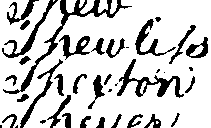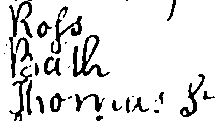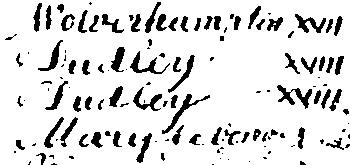In the example below;
- the Surname is THEWLISS.
- It looks like THEWLIFS but this is the old fashioned way of writing double S.
- The first S descends down to nearly hit the N but is barely visible.
- In the same example notice the exaggerated X in THEXTON this is typical.
- In THEXTON the thin part of the E is missing.

In this example;
- There is Ross showing the fs for ss
- In Bath the entering stroke for the t is above the baseline, this is normal.
The entering stroke is lower for an l(L)
- Thomas St showing a superscripted t

Deciphering Difficult Scans
The combination of a florid style, odd letter formation and poor reproduction can make reading some images
difficult.
The next 5 examples are from a difficult scan. We will look at four from the top, pretty
unreadable, and one from the bottom, readable.
The bottom part first
- The Indexer appears to be holding the pen in a slightly more East-West fashion
- They are pressing harder on the down-strokes and very lightly on the up-strokes
- The up-strokes have largely been lost on the scan, especially noticable in the W of
Wolverhampton and the M of Marylebone
- But the Volume numbers are clear and may give us a clue
- The 2 central districts are Dudley with the flourishes of the D missing

Now the very difficult top parts of the scan. We have to break down our detective work
into manageable chunks and use some of the tools mentioned at the top of this web page.
We have 2 unreadable Districts in each of the four examples:
- The first example
- The first district
- There is a possible ham at the end with maybe 3 letters before
- A very clear XX in the Volume column
- Look at the Districts sorted by Volume list, section XX, for a District ending in ham
- Oldham sticks out
- On the scan the ldham portion is now clear, but what about the O?
- The O has been formed starting at the top in a clockwise way, the left side is a firm down-stroke and the right side is a light up-stroke (missing)

- The second district
- The last letter could be d, l or t
- A cental letter with a descender
- A clearish XX in the Volume column
- From the Districts sorted by Volume list, Salford fits
- To be convinced this was Salford we need to compare some other characters in the same scan
- From Oldham it can be seen there are weak tops to the Ls
- Now look for another S somewhere else on the same scan, maybe a Sarah
- The second example
- The first district
- There is a horrible LEIGH. There is little difference between the capital letters L and S
- The second district
- In Preston, the loop of the P is rarely seen

- The third example
- The first district
- Another example of Oldham
- The second district
- Compare the first letter with Preston
- Volume is XXV
- When you locate Penrith in the Districts by Volume list it becomes obvious and helps confirm the Preston

- The fourth example
- The first district
- Another example of Oldham showing the weak right side of the O
- The second district
- Bolton is easy now
- Another short L

A final word of caution
In the examples above, we have seen how it is possible to use all the information at our disposal to
discover what an apparently unreadable entry says. Notice, however, that in each case, having used clues to
gain an idea of what an entry might be, we go back and test whether the entry really does correspond to our
theory. If it doesn't, then no matter how convinced we are that the entry must say that, we don't make the assumption.
In this respect, the transcriber should place himself in the place of a detective. He may be sure in his own mind
of the culprit, but unless he can prove it beyond doubt, he cannot proceed.
FreeBMD Main Page

 Reading the Writing
Reading the Writing
 Reading the Writing
Reading the Writing North-East to South-West
North-East to South-West

